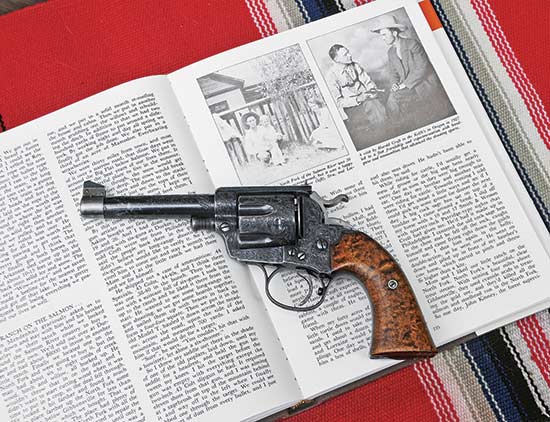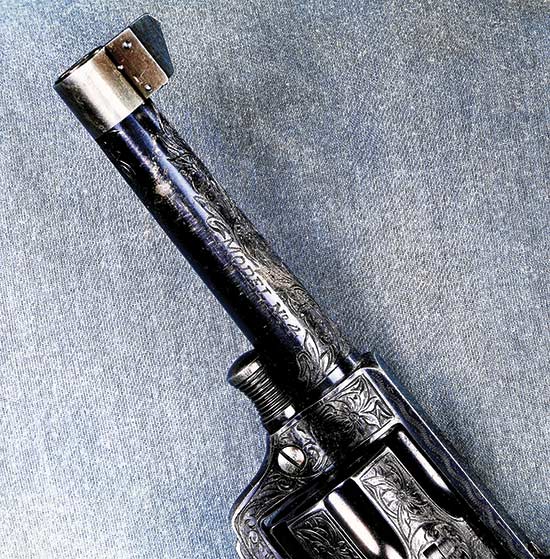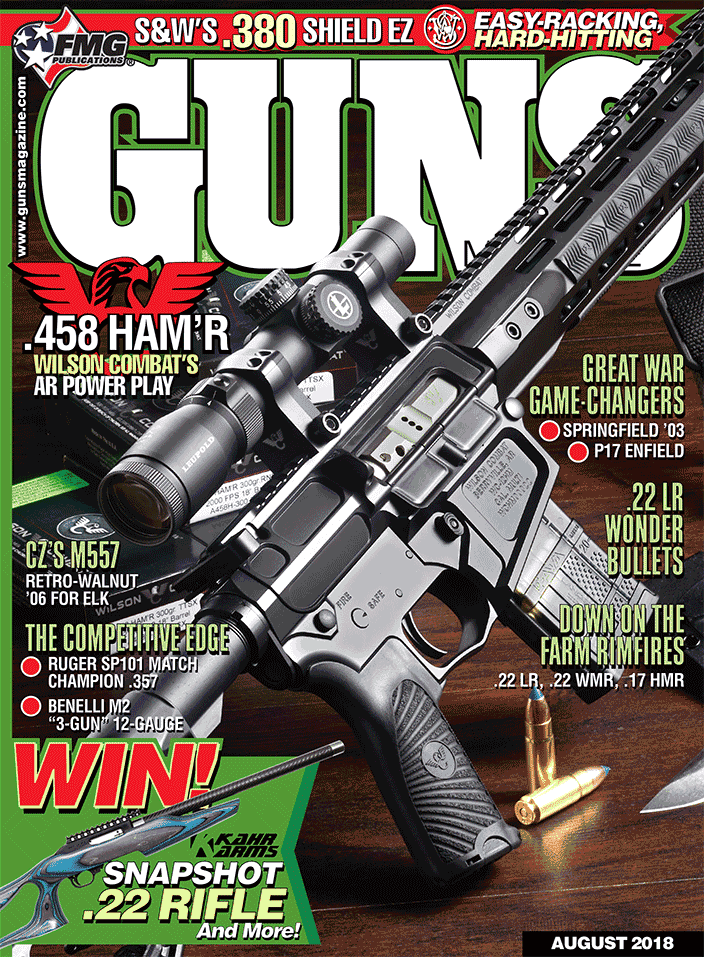If Guns Could Talk…
We’ve all come across a particularly interesting classic gun we wished could talk. But sometimes they do talk — at least a little.
Thanks to readers I’m often able to share their stories. In these pages I once talked of “The Croft Connection.” In the late 1920s Harold Croft left Pennsylvania with a suitcase full of sixguns and rode the train out to visit Elmer Keith, who at the time had a small ranch in Durkee, Oregon. Croft was into lightweight, easy packin’ pistols at the time, starting with Colt Single Actions and Bisley models.
The Ultimate Custom SAA
Elmer Keith was more interested in full-size single actions for long-range shooting and everyday packing. Croft’s ideas for perfect sixguns had been turned into reality by gunsmiths Sedgley and Houchins (with the former doing all the framework and the latter doing sights, stocks and actions). On this trip west Croft took four “Featherweight” (his term) .45 Colt custom SAAs to share with Keith. These four sixguns were specially numbered M1 and M3 on the Single-Action frames while the pair of Bisleys were M2 and M4. They were turned into Featherweights by hollowing out the recoil shield and removing the ejector rod and assembly.
The frame was narrowed down in front of the triggerguard, and the loading gate hollowed out. These techniques are still used by custom ’smiths today. The frames were also flat-topped and fitted with adjustable sights (another “modern” service provided by today’s customizers). All of Croft’s guns weighed between 30 and 32 oz. and were written up in the American Rifleman by Keith in 1928.
Croft obviously inspired Elmer and in the April 1929 American Rifleman Keith unveiled his ideas in an article entitled “The Last Word.” His perfect sixgun was a full-size, 5-1/2″ .44 Special incorporating many of Croft’s ideas and brought to life by gunsmiths Sedgley, Houchins and J.D. O’Meara. Since Croft had numbered his custom sixguns M1 through M4, Keith called his .44 Special the “No. 5 SAA.” This sixgun — along with Croft’s ideas — would have a long-ranging effect on revolvers throughout the rest of the 20th Century and beyond.
In early 2005 I was contacted by a reader who happened to have Croft’s M1. Earlier I had seen and handled M2. Both had two dates on them. On the left side of the frame we find “May 13 1925” while “April 5 1927” is on the right side. Both were originally .45 Colt and were now .44 Special, so I’m assuming Croft had his influence on Elmer Keith while Keith in turn influenced Croft to change his original 1925 sixguns from .45 Colt to .44 Special in 1927. Thanks to reader Sam Reed who had M1, I was able to “connect” with both Keith and Croft and shoot this historic sixgun.
But what of the other two Croft sixguns? I’ve often wondered if they would also surface, and now one has. Reader Mac Bowen shares the following information:
“In 1981 I was invited to attend a small private-estate firearms auction in Terre Haute, Indiana. At the time I was a factory representative for Interarms, the small arms giant. I was also an ardent student and collector of antique and classic firearms. The auction was part of an estate of a local deceased doctor, consisting of 25–30 guns.
“Upon viewing the guns, I immediately spotted the Croft #4 Featherweight chambered in .45 Colt, as altered by Sedgley and so marked on the top strap. The barrel is 4-1/2″ in length with no ejector rod. The immaculate grips are curly maple and the exquisite engraving is attributed to Wilbur Glahn. This is the very revolver pictured in Elmer Keith’s Hell, I Was There on page 126 as he was sitting next to Harold Croft in 1927. To the best of my knowledge, my No. 4 is the only Croft-Keith revolver that is still in the original .45 Colt chambering.”
So of the original four Croft Featherweights, three have now surfaced and, of course, even though this one and the others have talked to us, there are still questions remaining. How did this Croft gun wind up in Indiana? Why were the others converted to .44 Special and this one wasn’t? Where is M3 and is it still a .45 Colt or has it also been turned into a .44 Special? It’s taken all this time for three of these guns to surface. Will the final one show itself?
A Matchless National Match
In between the two world wars, John Henry FitzGerald, “Fitz,” was the public face of Colt and often talked of special match-grade 1911s, both in .45 ACP and .38 Super. After Fitz passed, Colts continue to be upgraded by various gunsmiths. Another historic .45 has been shared by reader Allen Sandifer. He found his on an Internet auction in 2011 and shared this info with me:
“It’s described as a Springfield Armory Arsenal Refinish National Match Pistol. These guns, as Flayderman puts it, were United States military issue which were sent to Springfield Armory Arsenal for rework. This one is marked US Army. They were refinished and set up as National Match pistols for use in National Match competitions. A very small number that were unused and unfired were put out for sale to the public. This occurred from the late 1950s to the mid-1960s.
“This is one of the Colt/Remington Rand hybrid guns that has the Colt slide and Remington Rand frame. Note this type of combination is listed in all the major 1911 texts… It has all the correct proof marks for this type of combination…. The gun shows as new. There are no cycling marks on the barrel, the breech, the hammer or any part showing it being fired. This gun comes with two new magazines that don’t even appear to have been put in a gun as they are flawless with no scratches or wear marks. The gun looks to have never been placed in a holster. I do not have any paperwork from the Springfield Armory Arsenal on this 1911. The barrel is marked ‘National Match’ as is the frame. The grips also appear to be brand-new as the checkering is still so sharp it will cut you.”
S&W’s Ultra-Rare .44
So within a couple of months two different readers have provided me with outstanding information about two historic .45s, however that’s not all. I also heard from reader Bob Fenton who has one of the rarest of all the Smith & Wesson .44 Specials. It’s a sixgun I’ve lusted for ever since Elmer Keith’s book Sixguns appeared in 1955. On page 240 is a picture of a 6-1/2″ .44 Special along with calipers, a couple of expanded bullets and the following caption:
“A .44 Sp. S&W Model 1926 Target with King red bead reflector front and white outline rear sights. Middle bullet was recovered from a deep snowbank after passing broadside through jackrabbit. Bullet on right expanded to diameter of 0.865″ on passing broadside through upper part of deer and lodging just under hide on opposite side. Distance of shot was 70 yards. Keith hollow point 235 gr., 18.5 gr. of 2400.”
The 1926 Target Model is so rare I never ever saw one until a couple years back when the Smith & Wesson Collectors held their annual meeting here; so it took over 55 years for me to ever see one. There were two on display priced from $8,000 to $10,000. Bob Fenton had been shooting his .44 Special (which appears to have Roper stocks) for many years using the Keith full-house .44 Special loads. He didn’t realize what he had until he read somewhere about my mentioning the rarity of this classic. He has used it shooting in combat matches and the pictures show it has been used. But it’s in fine shape on the inside and is still in service.
Shooters have always wondered how .44 Special sixguns — especially these older pre-WWII models — would hold up to heavy use with the Keith load. Bob’s 1926 Model has certainly stood the test!
In the quote above Elmer mentioned a load of 18.5 grains of 2400 which was his load for the old “balloon head” brass. After the .44 Special brass was changed to solid head, thus reducing the case capacity, he changed this load to 17.0-17.5 grains of 2400 in the 1950s. Today’s 2400 is considered to be slightly hotter and most shooters reduce the loads at least 6 percent. I’ve taken it a step further and do not go above 15.5 grains with any recently produced large-frame .44 Specials and I definitely do not use loads anywhere near this heavy in pre-war sixguns.
It’s always interesting to hear from readers as they share their experiences and information with historic old guns. Who knows what fascinating information the next phone call, e-mail or letter will contain?








